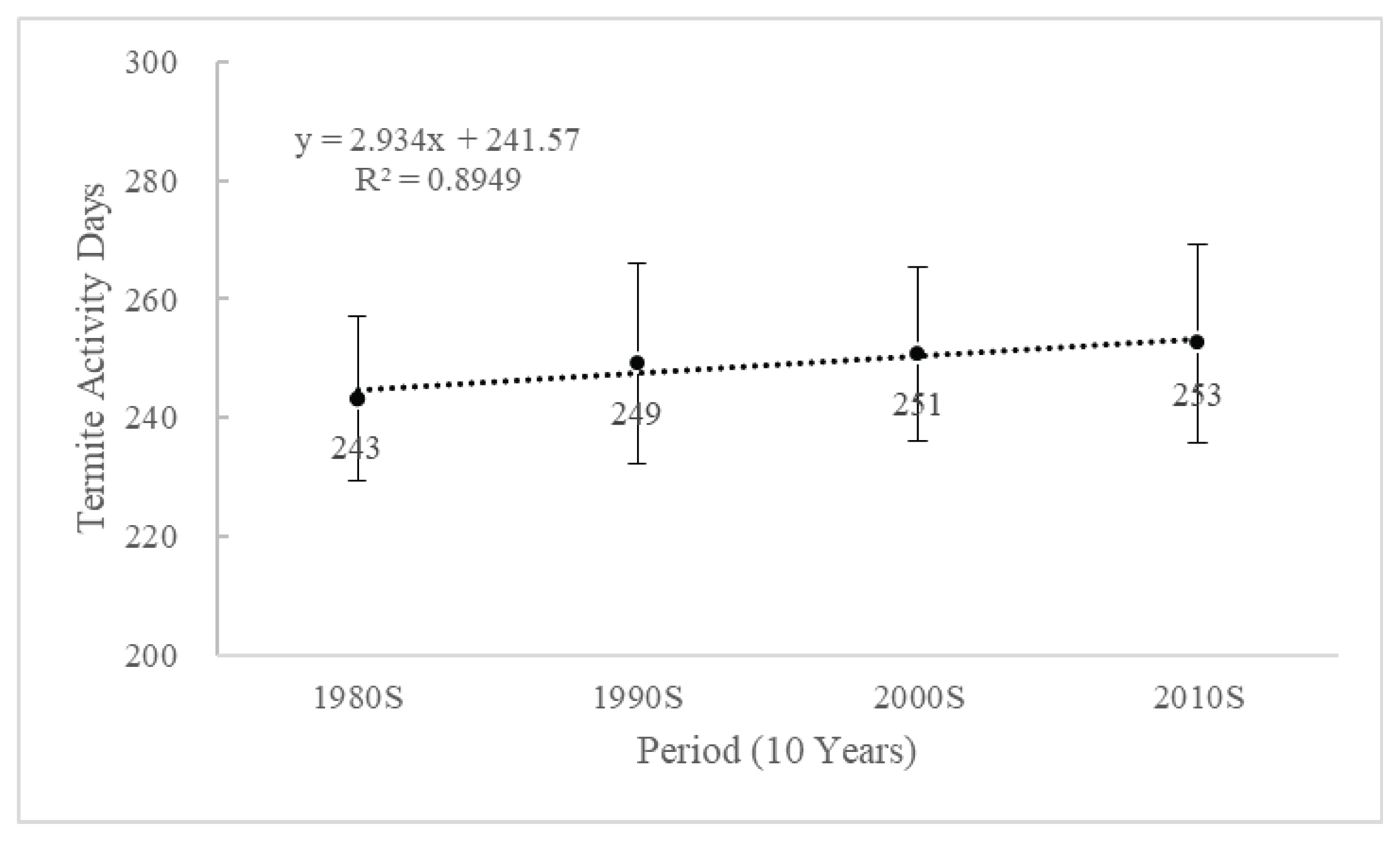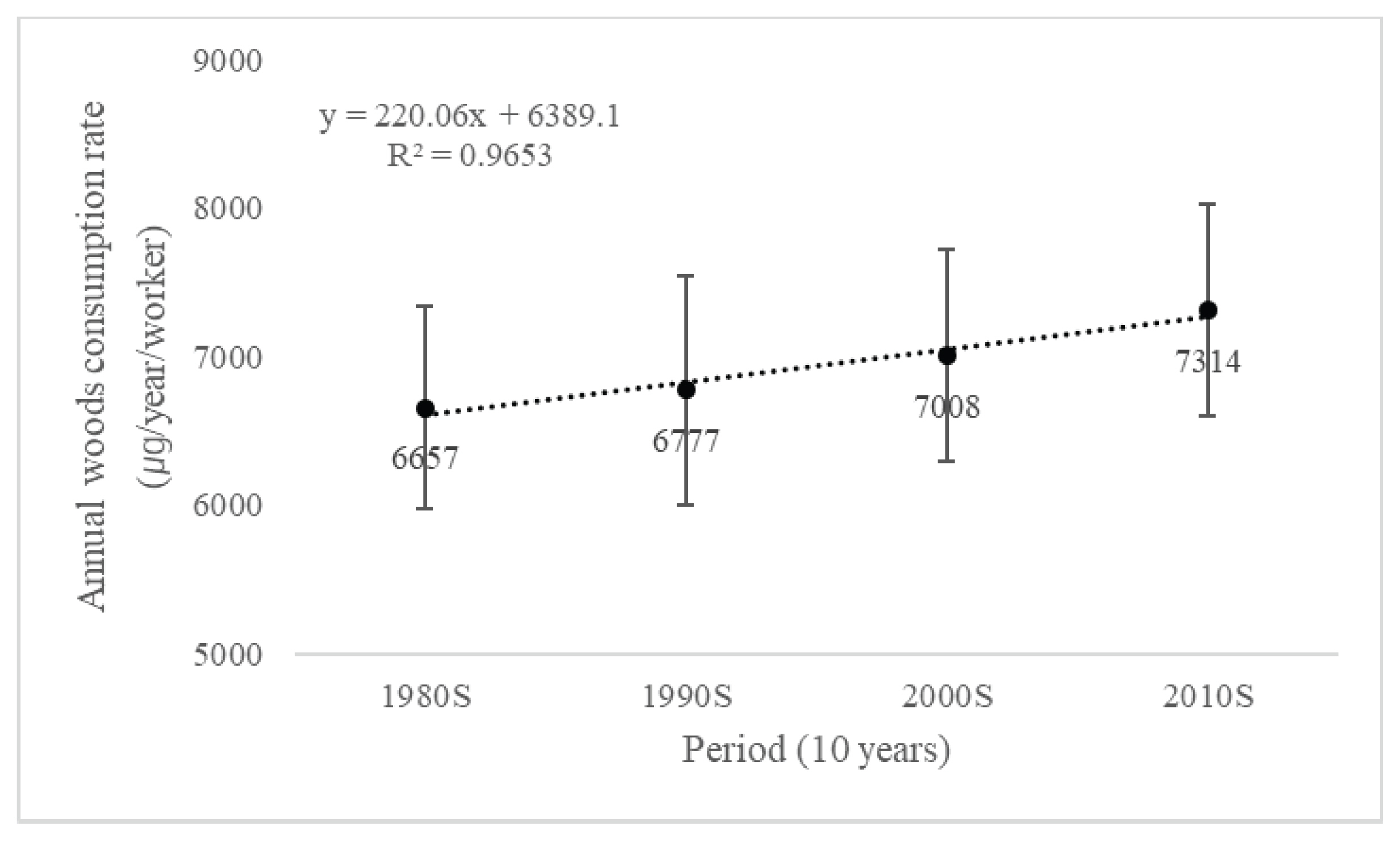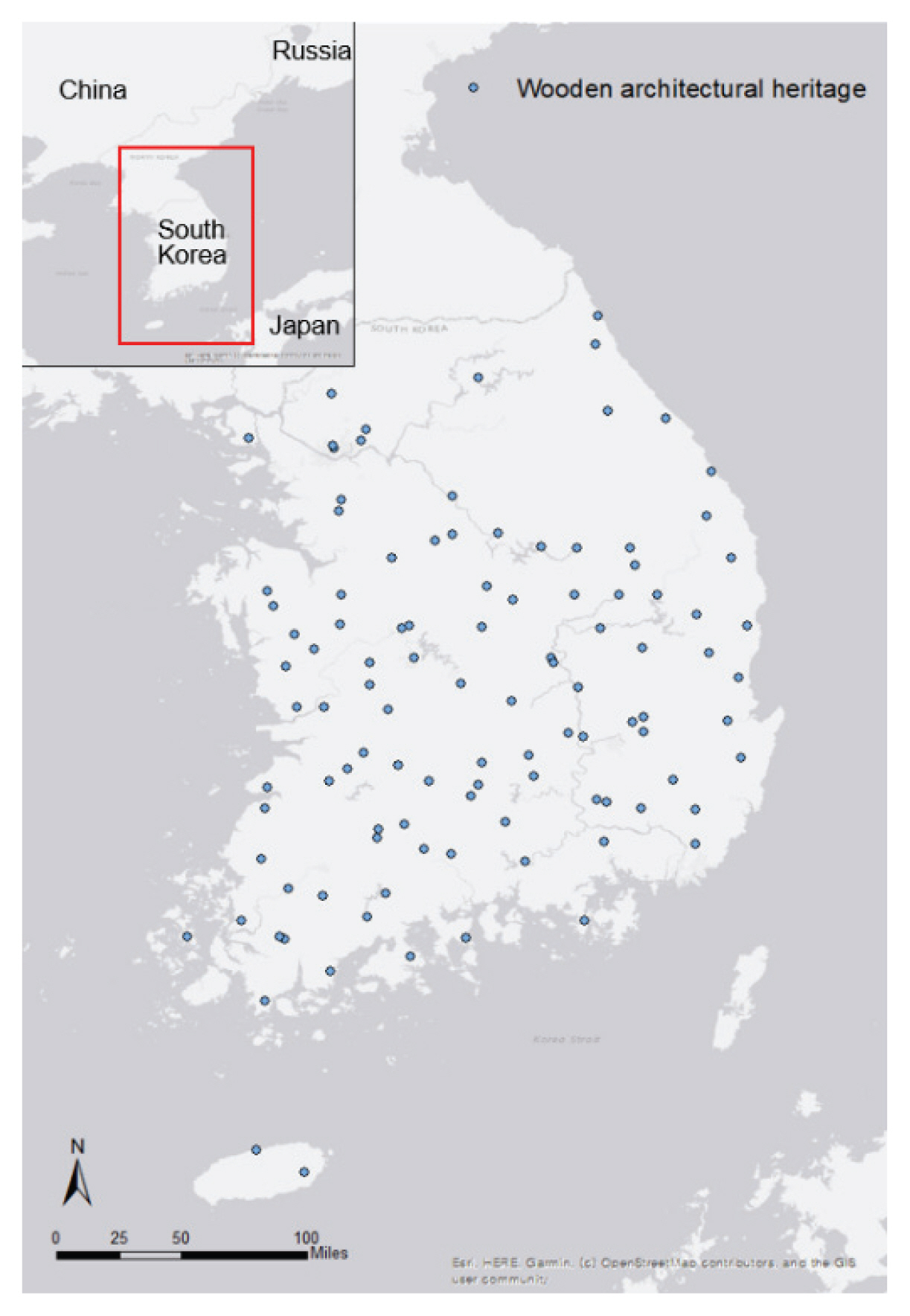Korean Wooden Architectural Heritages at An Increased Risk of Termite Damage due to Temperature Change
Article information
Abstract
Wooden architectural heritages in Korea have been severely damaged by termites, and this damage is expected to increase owing to climate change. This study aimed to evaluate the changes in termite damage risk due to climate change specifically in Korean wooden architectural heritages. A multiple regression equation was developed to estimate the daily average temperature from the location information (latitude, longitude, and elevation) for 40 years (1980–2019). The location information of 106 nationally designated wooden architectural heritages distributed across 84 cities was used to estimate the daily mean temperature of each cultural heritages. Referring to a previous study on the ecological characteristics of R. speratus, a dominant termite species in Korea, the temperature at which termite activity is possible was confirmed, and the amount of wood consumed in relation to the temperature change was estimated. Based on this, the number of days available for termite activity and the amount of termite wood intake in the 1980s, 1990s, 2000s, and 2010s were estimated. Consequently, we found that the number of active days for termites increased from 243 to 249, 251, and 253 days in each decade. The wood consumption rate also increased by 9.9% over 40 years, from 6,657 to 6,777, 7,008, and 7,314 μg/ worker/year, respectively. This study was the first to estimate the activity period and wood intake of termites in Korea’s wooden architectural heritages, thereby providing valuable information for the preservation and management of these wooden heritages.
1. INTRODUCTION
Many Asian countries, Including Korea, have numerous valuable wooden architectural heritage sites. The preservation and protection of these wooden structures is important for ensuring the longevity of these heritage sites. Wood can be damaged because of various factors; however, biological damage is a particularly serious problem (Pournou, 2020). In recent years, many wooden architectural heritage sites have been severely affected by termite damage. Termites are eusocial insects that digest various plant materials. Although they play an important role as decomposers in ecosystems (Brune, 2014), they can also damage wooden structures. Global economic losses due to termites are approximately 40 billion USD annually, most of which are caused by subterranean termites (Rust and Su, 2012).
The damage caused by termites not only represents economic loss, but also affects wooden heritage. In Korea, visually identifiable termite damage has been observed in 51% of nationally designated wooden architectural heritage sites (Kim and Chung, 2022a). Termite damage to wooden architectural heritage is associated with the location characteristics of Korean cultural heritage sites adjacent to forests and forest fertilization; however, the temperature increase due to climate change is also considered a critical factor (Kim and Chung, 2022b).
Temperature is a factor that directly affects the activity of termites, and the distribution range of termites is determined by the lowest temperature of the area (Deleplane et al., 1991; Hu and Appel, 2004). Recent climate change is expected to increase the minimum temperature, which will gradually expand the range in which termites can live and increase their activity periods (Hughes et al., 2008). A recent study reported that wood decomposition by termites was 6.8 times higher at 10°C higher temperatures (Zanne et al., 2022).
Therefore, termite damage to cultural heritage sites is expected to increase, and basic research on how climate change affects termite activity is required to prevent this. In this regard, Kim et al. (2023) scholars have examined the changes in termite activity in response to temperature changes over the last 100 years in South Korea. However, owing to the limitations of accumulated meteorological data, their study only estimated the termite activity changes in seven cities, rather than in actual wooden architectural heritage sites.
To address the aforementioned research gap, this study aimed to collect daily mean temperature from major wooden architectural heritage sites of Korea and analysed how an increase in temperature over the past 40 years has affected the activity period and activity of termites in these heritage sites. Consequently, this study provides the relevant authorities with valuable insights for designing appropriate measures to prevent termite damage for protecting these heritage sites.
2. Materials and Methods
2.1. Daily mean temperature
The daily mean temperature for each cultural heritage site was estimated using location information.
To determine the active period of termites at each cultural heritage site, it was necessary to determine the heritage sites’ temperature. Most cultural heritage sites in Korea are located in high―altitude mountains, but most weather stations are built in low―lying downtown areas, making it difficult to directly use meteorological data observed at meteorological stations for a climate―related analysis of heritage areas. Therefore, in this study, the daily mean temperature of each cultural heritage site was estimated using location information based on the methods outlined in previous studies (Kim and Chung, 2022b; Kang et al., 2021).
First, the daily mean temperature data for each meteorological zone were collected from the Open MET Data Portal (http://data.kma.go.kr) operated by the Korea Meteorological Administration. A total of 72 weather stations collected daily mean temperature data for 40 years (14,610 days) from January 1, 1980, to December 31, 2019. However, data from 13 weather stations with more than 11 missing days in each decade were excluded. Therefore, we considered the daily mean temperature and location (latitude, longitude, and altitude) data from a total of 59 stations. Using the collected data, we developed a multiple regression equation with latitude, longitude, and altitude as independent variables, and daily mean temperature as the dependent variable.
2.2. Wooden architectural heritage sites
Next, 106 representative sites were selected from the list of nationally designated wooden architectural heritage sites (National Treasures, Treasures, and National Folklore Cultural Heritage sites) in Korea. The study sites were distributed across 84 cities country wide (Figure 1). A list of study sites has been provided in Appendix 1. Location information for each cultural heritage site was inputted to the developed multiple regression formula to estimate the daily mean temperature for each cultural heritage site for 40 years from 1980 to 2019.
2.3. Changes in termite activity based on cultural heritage site
Analysis of termite activity changes in response to temperature changes was performed using the method described in a previous study (Kim et al., 2023) and involved the use of two indicators: the number of days the termites can be active and the amount of wood they eat. Three species of termite have been reported to inhabit Korea; however, Reticulitermes speratus (R. speratus) is distributed nationwide and is the main species responsible for damages to the cultural heritage sites (Kim and Chung, 2022b). Therefore, in this study, the activity change of termites was estimated based on the ecological characteristics of R. speratus, which exhibits a high survival rate in the range of 10–30°C. Moreover, as the temperature increases, the amount of wood eaten increases, but when the temperature exceeds 32°C, the survival rate decreases rapidly owing to the death of the intestinal symbionts (Lee and Jeong, 2004). Therefore, in this study, the number of days in which the daily mean temperature was between 10 and 30°C was defined as the “number of days available for termite activity” (NDATA) for each cultural heritage.
Next, the amount of wood that termites could consume when they were active (NDATA), was defined as the “estimated amount of termite wood intake” (EATWI). To calculate the EATWI for each cultural heritage site, a regression equation for the wood intake based on temperature was developed by referring to previous studies on the change in wood intake with the change in temperature (Lee and Jeong, 2004; Nakayama et al., 2004). The EATWI for each cultural heritage site was calculated by inputting daily mean temperature values. The EATWI by each termite was calculated as the amount of wood eaten by one termite per year (μg/worker/year). All statistical analyses were performed using IBM SPSS Statistics for Windows version 21 (IBM, US).
3. Results
3.1. Changes in the NDATA by major cultural heritage site in Korea
Figure 2 shows the results of the change in the number of days of termite activity from 1980 to 2019 at 106 major wooden cultural heritage sites of Korea. The changes over time for each cultural heritage site are presented in Appendix 2. Over the 40-year period considered, the NDATA increased by 9.2 days on average, and there were differences in the degree of increase for each cultural heritage site.

Changes in the number of days available for termite activity at 106 major wooden architectural heritages in Korea (1980–2019).
The long―term trend showed that NDATA increased by approximately three days every 10 years (R2 = 0.8949) (Figure 2). The increase was greater in the 1990s. Compared with the NDATA in the 1980s, the NDATA in each subsequent decade increased by 5.8, 1.7, and 1.7 days, respectively. However, compared with that in the 1980s, the median NDATA increased by 1.0, 5.5, and 1.0 day for each subsequent decade, with a relatively large increase in the 2000s. In the 2010s, compared with the 2000s, the mean temperature between March and November increased, but the mean temperature between December and February decreased; therefore, the increase in termite activity was not substantial.
3.2. Changes in the EATWI by major cultural heritage sites in Korea
Figure 3 shows the changes in the EATWI at 106 major wooden cultural heritage sites in Korea. Changes over time for each cultural heritage site are presented in Appendix 3. The long―term trend showed that the EATWI increased approximately 220 μg every 10 years (R2 = 0.9653). Termites ate 6,657 μg of wood in the 1980s, 6,777 μg in the 1990s, 7,008 μg in the 2000s, and 7,314 μg in the 2010s. The average increase in the EATWI was 9.9% in the 2010s compared with that in 1980s.

Changes in estimated amount of termite wood intake at 106 major wooden architectural heritages in Korea (1980–2019).
The rate at which the EATWI increased rose every 10 years, exhibiting a pattern similar to that of NDATA; however, there were differences in the details. Compared with the 2000s, the extent of the increase in NDATA was small in the 2010s, but the that of EATWI was similar between the 2000s and the 2010s. In the 2010s, compared with the 2000s, the March―November temperatures tended to increase, and the December―February temperatures tended to decrease. Because the NDATA is defined as the number of days with a daily mean temperature of 10°C or higher, the increase in temperature from April to October, when termites feed most on wood, showed no effect. However, because the EATWI was positively correlated with temperature, it increased in proportion to the increase in temperature from April to October, when the monthly mean temperature was high.
4. Discussion and Conclusion
In this study, we attempted to quantitatively evaluate whether rising temperatures due to climate change affect the activity of termites and thus pose a threat to the preservation of Korea’s wooden architectural heritage. We analyzed the changing trends by estimating the daily mean temperatures of 106 wooden architectural heritage sites in Korea from 1980 to 2019. The results showed that the annual average temperature continued to increase from 11.6°C to 12.2°C, 12.4°C, and 12.6°C per decade from the 1980s to the 2010s. Minimum monthly mean temperatures, which have the greatest impact on termite species, distribution range, and duration of activity, showed an overall increasing trend, varying from −2.4°C to −1.1°C, −0.8°C, and −1.5°C from the 1980s to 2010s.
Using the estimated daily mean temperatures, changes in the NDATA and EATWI at major cultural heritage sites were analyzed. Compared with the 1980s, the NDATA in the 2010s increased by 9.2 days (+ 3.8%) from 243.3 to 252.5 days on average, and the annual wood intake per termite increased from 6,657 to 7,314 μg, representing an increase of 657 μg (+ 9.9%). The NDATA increased relatively more in places where the NDATA was higher among all cultural heritage sites. In contrast, the EATWI increased relatively more in places where the termite wood intake was estimated to be low.
The results of the study showed that the monthly mean temperature in March increased by 1.2°C, from 4.9°C in the 1980s to 6.1°C in the 2010s. In addition, the monthly mean temperature in November, when termite activity starts to decrease, increased by 1.1°C, from 6.7°C in the 1980s to 7.8°C in the 2010s. It is estimated that the overall activity period of termites will increase due to the above―mentioned increase in temperature; if the average period of termite activity in Korea in the past was from April to October, it is now estimated to extend from March to November.
The wood consumption per termite population estimated in this study have increased by approximately 10% over the past 40 years. This figure does not include termite density. Moreover, changes in temperature have been shown to affect termite foraging activity (Cornelius and Osbrink, 2010; Gautam and Henderson, 2011), egg production of outdoor colonies (Matsuura and Kobayashi, 2007), and molting cycles (Kakkar et al., 2016), all of which have a positive effect on termite activity. Therefore, as the temperature increases, termite damage is expected to increase significantly owing to a combination of increased termite density, wood intake per individual, and colony foraging rate.
In addition, increasing temperatures increase the risk of invasive termites becoming native to South Korea. The Formosan subterranean termite, the most damaging termite species in the world, is not yet to be found in South Korea. However, as the winter temperatures rise, the southern part of Korea is already within the species’ survival range, and this range is expected to expand gradually as temperatures increase in the future (Lee et al., 2020).
New colonies can easily reinvade places where termite damage has already occurred, even if the existing colonies are removed (Su et al., 2016). Most of Korea’s wooden architectural heritage has been damaged by termites, and their proximity to forests has made it accessible to termites. In addition, unlike general wooden buildings, controlling termites in historic wooden buildings is more difficult because the control methods that can be applied to cultural heritage sites are limited; therefore, more active monitoring and preventive control must be implemented to reduce termite damage to cultural heritage sites.
To the best of our knowledge, this was the first study to estimate the extent to which temperature changes affects the increase in termite activity and damage in South Korean wooden architectural heritage sites. Based on this study’s results the government can implement measures to control termite damage in wooden heritages.
ACKNOWLEDGEMENTS
This study was supported by the National Research Insitute of Cultural Heritage (Project No.: NRICH-2305-D12F-1)
This is a revised paper presented at the SAHC 2023 (The 13th edition of the International Conference on Structural Analysis of Historical Constructions) conference.
